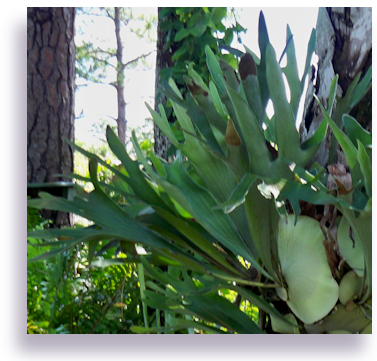Staghorn Fern
Staghorn Ferns
 Of the 17 or so species of mostly tropical staghorn ferns, Platycerium bifurcatum is the most commonly imported into the United States. Unlike most other staghorns, Platycerium bifurcatum is able to withstand freezing temperatures, so can be grown as far north as zone 5A.
Of the 17 or so species of mostly tropical staghorn ferns, Platycerium bifurcatum is the most commonly imported into the United States. Unlike most other staghorns, Platycerium bifurcatum is able to withstand freezing temperatures, so can be grown as far north as zone 5A.
I was at a Home Improvement store just last week, and saw a lady putting a small staghorn fern into her car. I politely smiled and mentioned to her that I had bought a smaller one than her just a few years back, and attached it to a palm tree that tilts. It has since grown to well over 2 and a half foot across, and almost as tall.
The stunned look on her face took me aback, and then she told me that eventually the fern would kill my tree. I said nothing, not wanting to sound like a know∼it∼all, and said goodbye and good luck to her.
I told you that story because it is simply not true. Sadly, many people do believe this. Staghorn ferns are epiphytes and do not do anything to their so called host except use it as an anchor. They derive no nutritional intake from the host plant. Instead, the staghorn fern gets it's nutrients from miniscule particles floating in the atmosphere, from rainwater, and falling leaf debris that might gather in the sterile leaf cup.
Most people nevertheless attach the staghorn fern to large flat boards such as plywood, and this is really a convienient way to display them. They can be moved more easily in this fashion, and if you end up with a tropical species, it can be taken inside when frost threatens. Staghorn ferns overwinter fairly well, as they require no direct sunlight even when placed in the landscape, but continuing to water is still required, as staghorns do need a lot of moisture to thrive.
I place a broken up fruit and nut fertilizer spike into the sterile leaves that stick out in the spring of each year. Throughout the year, I keep it moist with the gardening hose set on shower for a few minutes every other day, unless rains are forecast. Rainwater is much better for them than our sulfury well water, so I take advantage of the rains whenever possible. The plant has flourished.
Staghorn ferns have two distinct types of leaves, which is unlike all other ferns. One type, called the sterile leaf, is actually produced by the plant to be used as a support system and nutrient gatherer. It grows flat at first, attaching itself to whatever the spore is on. As the sterile leaf begins to age, it dies and is replaced with another sterile leaf. Out of the sterile leaf grows the fertile leaf. This is the long, antler like leaf projections you see and admire. These leaves produce spores when mature. The spores can be seen on the underside top of the leaves, and are brown and furry in appearance.
These fertile leaf spores can be gently scraped off, sprinkled above moistened peat with ground up sphagnum moss, and then covered with a clear plastic dome with ventilation to hold in moisture. Beware of too much moisture if you are doing this, and remove the top in the heat of the day to allow for better ventilation. Germination is sporadic, but if you do it right, you will end up with baby staghorns.
My now adult Platycerium bifurcatum is as I said, on a cabbage palm in our yard. It does get some strong afternoon sun, but since it has grown there since it was very young, I think it has adapted. And I keep it moist, to counteract the sunlight.
To see the magnificent specimen above in it's full glory, go to the link on staghorns on the below right.
Tags: staghorn fern, staghorn fern, Platycerium bifurcatum, Common Staghorn Fern, Elkhorn Fern, Antelope Ears Platycerium bifurcatum


